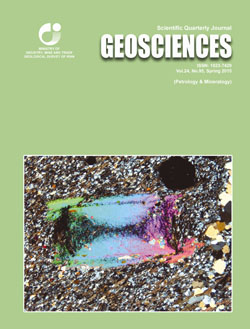Document Type : Original Research Paper
Authors
1 Ph.D. Student, Department of Geology, Islamic Azad University, Science and Research Branch, Tehran, Iran
2 Professor, Department of Geology, Faculty of Natural Sciences, University of Tabriz, Tabriz, Iran
3 Assistant Professor, Department of Geology, Islamic Azad University, Science and Research Branch, Tehran, Iran
4 Assistant Professor, Department of Geology, Islamic Azad University, Mashhad Branch, Mashhad, Iran
5 Ph.D. Student, Department of Mining Exploration, Amirkabir University, Tehran; Geological Survey of Iran, Northeast Territory, Mashhad, Iran
Abstract
The Neian epithermal deposit in northwest of the Lut block is located in ~35 km southwest of Bejestan. The studies done on this deposit indicate the development of zonation in altered rocks around the ore-bearing siliceous veins and the existence of silicic (quartz, chalcedony, adularia, calcite, illite, and sericite), silicic-argillic (quartz, adularia, illite, sericite, and pyrite), argillic (illite, quartz, calcite, adularia, sericite, kaolinite, smectite, and chlorite), and propylitic (chlorite, calcite, albite, epidote, quartz, and smectite) alterations as the major alteration zones in this deposit that were formed during the five stages. Th geochemical diagrams, molar elemental ratios, and petrographic consideration illustrate the presence of transitional transformation and mineral conversion arrays during the development of hydrothermal system at Neian. Consideration of these diagrams indicate a wide spread of argillic and silicic and a relatively limited extent propylitic alteration zones in the Neian deposit. These diagrams also show that the mineral arrangements such as plagioclase-illite, plagioclase-adularia, illite-adularia, and plagioclase-smectite were developed during the prograde stages, whereas adularia-illite arrangement was formed during the retrograde (waning) stages of hydrothermal system. Permeability, high water/rock ratio in the host rocks (generated by faulting and the presence of extensive pyroclastic rocks) are the main factors for development of alteration zones and formation of widespread adularia in the area. In addition, considering the mineralogical composition of the deposit, the presence of minerals such as adularia and illite in the central and kaolinite in the peripheral part of the system may suggest that they were formed by the fluids having temperatures > 220 °C and <140 °C, respectively. The presence of mineral assemblage of quartz, adularia, illite, pyrite, chlorite, and calcite may reflect the involvement of upward flowing Chloride-bearing fluids with pH ranging from almost neutral to moderately alkaline. The contemporaneous formation of calcite, smectite, illite, and kaolinite in peripheral parts of the system was resulted by the reaction of CO2-rich fluids (containing hot vapors) with the host rocks. Increasing of temperature and potassium metasomatism in the central parts of the system caused widespread formation of illite at the first stage of alteration and of adularia-illite at the second (maximum K-metasomatism) during the geothermal activity at Neian. Concurrent with the waning stage of hydrothermal alteration and decreasing of K-metasomatism, illite replaced adularia again. The prevalence of conditions (for a long period of time) suitable for stability of illite may account for the greater abundance and extent of this mineral relative to adularia in the host rocks of Neian deposit.
Keywords

